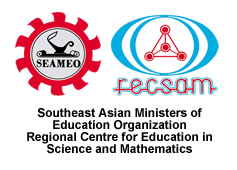Editorial Board (Issue 5 - 2010)
Dr Azian T.S. Abdullah (Advisor)
Devadason Robert Peter (Chief Editor)
Dr Cheah Ui Hock (Editor)
Ng Khar Thoe (Editor)
Dr Hazura Ab Bakar
Dr Sheila Oyao
Contents
Ng Khar Thoe, Linda Toh, Boey Mei Li
The advent of the digital globalization era has resulted in an increasing demand for sustainable e-learning platforms to facilitate the sharing of best practices in science/mathematics education. Science across the World (SAW) is an international education flagship programme founded in 1990 by the Association for Science Education (ASE). The main objective of this programme is to provide a forum for students, aged 12 to 17 years, to exchange facts and opinions with youths around the world through a unique series of compact resource topics on environmental and social science issues. Since the inception of SAW, SEAMEO RECSAM has been the programme coordinator for the Asia Pacific region, playing a major role in promoting the teaching and learning of science via ICT integration. Over the past two decades, RECSAM has contributed towards human resource development; to provide training opportunities as well as coordinating capacity-building activities. Recently, the Centre has embarked on promoting project-based activities (PBA) and problem-based learning (PBL) to a wider audience aimed at achieving the ‘Education for All’ (EFA) mission. A web-based learning portal entitled ‘South East Asia Regional Capacity-enhancement Hub’ (SEARCH) has been developed to promote science and mathematics learning incorporating ICT, with more exchange of ideas and sharing of best practices, encompassing international cooperation via on-going e-research and capacity-enhancement activities. This article reports the first of a series of the completed and on-going SAW related activities with evidences of exemplary practices in SEARCH for youth science and mathematics researchers. Experiences from two SAW project schools will be elaborated. Educational implications and future direction will also be deliberated.
2. Case Study: What Does the Equal Sign Mean to Children? (pp 20 – 24)
Ronny Kwan Eu Leong
What an equal sign mean to a child might look trivial but it is a pertinent concept. The meaning of an equal sign is useful for the conceptual understanding of algebraic equations. In this paper, the main focus is to illustrate on a case study on the interpretation of the equal sign by a child in the elementary level. The clinical interview method contains several tasks to probe the understanding of the child on the equal sign. It is important for a child to know the different meanings of the equal sign that was used. In this case study, the child had a strong sense of the equal sign as an operator. However, in situations involving words and money, the child within the age group of elementary school level regarded the equal sign as a relational symbol between quantities.
3. Cardiovascular Prevention: Internet Resources for a Teaching Unit (pp 25 – 33)
Aldo T. Marrocco
In order to find stimuli for getting young students interested in the subject of Health, internet resources have been searched such as scientific contributions, atlases, images, diagrams and animations that help study cardiovascular prevention. The educational route is geared towards an increased awareness of the consequences of our behaviour on our health. The risk factors are determined to a great extent by behaviours learned in childhood and continued in adulthood, such as dietary habits, physical activity and smoking. The paper deals in particular with the primary prevention of heart attack and stroke. It can be noted, however, that compliance with its rules often produces benefits on other areas of health, for example bone growth and cancer prevention.
4. Observations of Mathematics classrooms in some countries (pp 34 – 40)
Ronny Kwan Eu Leong, Edward Ham
Comparative education is the field that generates lots of interest from educationists around the world. Many countries have their own unique methods in the teaching and learning of mathematics. It is important to observe the teaching of mathematics in the classrooms around the world. Not only one could gauge how mathematics education is implemented in one country as compared to others, but ideas for innovative mathematics teaching in classrooms could also be adapted with educational implications. In this article, the authors share their insight on the teaching and learning pedagogies implemented in the mathematical classrooms in Russia, Singapore, Cambodia and Vietnam.

